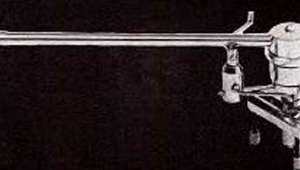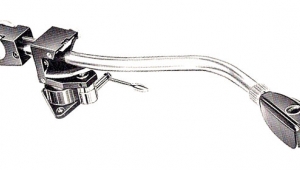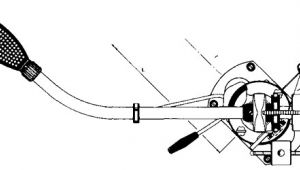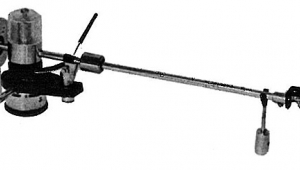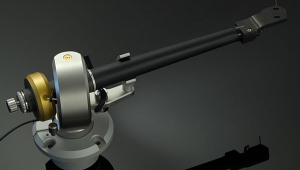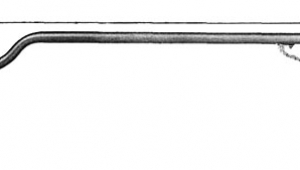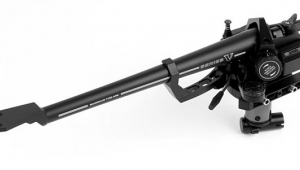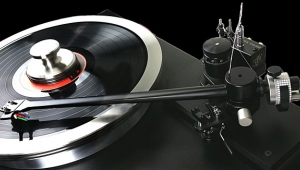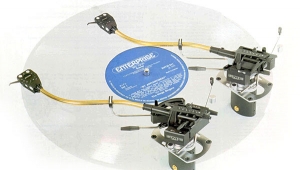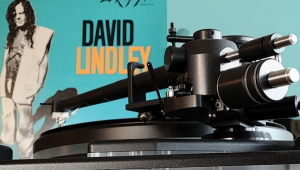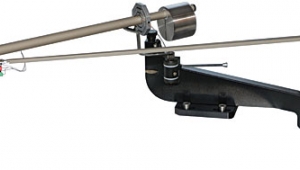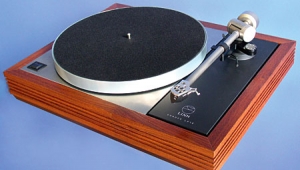| Columns Retired Columns & Blogs |
Kuzma Air Line tonearm Page 2
"In any arm/cartridge system, the arm should hold steady while the cantilever remains free to extract information from the groove. If the two were dancing partners, the cantilever would 'lead' and the arm would follow. In an undamped high-mass system the 'tail' (arm) begins to wag the dog (cantilever). Unwanted cantilever movement creates unwanted electrical output. In addition, any electrical output created with the coils uncentered in the magnetic gap is nonlinear, thus making it virtually impossible for the cartridge to act as a linear transducer, which is its job. Cantilevers can actually snap in undamped linear-tracking systems....In my opinion, a linear-tracking arm without damping is simply not viable if the goal is a 'reverse machine tool' accurately tracing what's in the groove."
It is thus inexplicable to me that Kuzma, a designer who, by every indication, clearly understands all of these issues, chose to omit a damping trough, which wouldn't have been all that difficult to implement. It's like not including shock absorbers in an automobile. While using a low-compliance cartridge will mitigate this problem to some degree (and using a cartridge of low compliance and relatively high mass is mandatory with the Kuzma), I believe the problem still exists.
Setup
Installing and setting up the Air Line was relatively easy. The massive main housing terminates in a large threaded bolt that's compatible physically and geometrically with the circular cutout used for many pivoted designs. An armboard cut for the Morch arm worked fine once the hole's diameter had been increased. The small-diameter air hose, which is stiff but still sufficiently flexible to allow it to be dressed, attaches to the arm via a push-lock connector.
Kuzma provides a straight run of cable from the cartridge clips to a set of Bullet RCA plugs at the end of an ample length of high-quality interconnect. As with the Rockport, the thin tonearm wire is fixed in an arc to minimize interference with arm movement.
Kuzma supplies a straight-line protractor, attached to a paper jig, that makes it easy to establish a radial line before you lock down the arm mount. From there, mounting the cartridge and setting its overhang, VTF, VTA, and azimuth are fast and easy. However, establishing an initial reference VTA, with the axis of the tonearm parallel to the record surface, would be considerably easier if Kuzma would scribe a straight line on the side of the tapered armtube, as SME does.
The rigid headshell is slotted for setting overhang, a locking threaded counterweight on a long shaft sets VTF, a dual-scale, precision-locking threaded VTA adjustment smoothly raises and lowers the main housing (and lets you know exactly where you've set it), and a worm-gear mechanism similar to what Herb Papier designed for his Tri-Planar arm permits precise adjustment of azimuth. Setting up the Air Line couldn't have been more easy or reassuring: the settings lock into place.
The tapered armtube attaches to a massive machined aluminum block that completely encircles the air bearing. A sure-feel cam-actuated rod applies the cueing mechanism, which lets you precisely stop the arm's travel at any height within its adjustment range.
Everything about the execution of this well-crafted design screams rigidity, security, and repeatability. It's everything the cumbersome air-bearing arm that came with the V.Y.G.E.R. Atlantis turntable wasn't (see "Analog Corner," July 2003).
Like any air-bearing arm, the Air Line must be used on a level, stable platform. The lack of both friction and damping, combined with high horizontal moving mass, means the arm's stability and thus tracking effectiveness depend on its being absolutely level. Any slight deviation will pitch the arm in the direction of the slope. I used the "balancing plateau" on the Cardas Sweep Record to level my Sounds of Silence Vibraplane active isolation platform, and found it extremely difficult to keep the stylus from sliding in one direction or the other. Soggily sprung turntables need not apply.
Once set up, the Air Line was a pleasure to use, though the active Vibraplane tends to shift slightly over time; I had to level it often. Even then, occasionally at the end of an LP side the Air Line would slide into the record weight and then careen back across the record surface. Keep that in mind if you think you can get away with a less than ultra-stable, level platform.
Sound
Though the original Rockport Series 6000 tonearm received a deservedly gushing review, over time it became apparent that its low-frequency extension and solidity were not as good as the Graham 2.2's or the Immedia RPM2's. The 6000's relatively low vertical effective mass put its resonant frequency above the ideal 8-12Hz region with moving-coil cartridges of average weight and typically low compliance, causing the bass to begin rolling off prematurely. Andy Payor solved the problem on the System III Sirius arm—see my analogsourcereviews/review in August 2000—by adjusting the mass so that the arm's fundamental resonant frequency would be compatible with a wider range of cartridges.
Before switching from the Graham 2.2 to the Kuzma Air Line on the Simon Yorke turntable, I played a number of bass-heavy LPs. Judging by the Air Line's relatively long, massive, tapered armtube, I didn't think I'd run into the same bass problem. I didn't, but when I measured the horizontal resonant frequency using a few typical MC cartridges, it was very low—around 5Hz—making Kuzma's choice to omit damping all the more puzzling.
That said, and when all conditions were ideal, the Air Line's top-to-bottom performance was absolutely stunning, and comparable, as best as I can compare, to the Rockport arm on the Sirius. When you hear a true linear tracker for the first time, you'll know it—the absence of the etchy, pinched character present in all pivoted arms is among the most obvious differences. You're not really aware of it when listening to the best pivoted arms, but when it's gone, what a difference!
The Air Line's dramatic, solid, three-dimensional spatial presentation was very similar to that of the Rockport 6000, which I'd reviewed with a VPI TNT turntable. The Kuzma's bottom-end performance, however, was far more robust—going from the Graham 2.2 to the Air Line, nothing was lost in bass extension, and much was gained in bass texture and harmonic detail.
When I played the Beatles' "Baby You're a Rich Man" (from a true stereo pressing of Magical Mystery Tour, German Apple SHZE 327) with the Air Line after hearing it with the Graham 2.2, I was struck by the enormous overall improvement in the naturalness of transient attack and subsequent decay. The handclaps were far less brittle and far more solid, fleshy, three-dimensional, and convincing. The bass wasn't more extended, but it was more complex physically and harmonically, particularly the attacks—I could feel McCartney plucking the strings in a fundamentally different and more revealing way. Front-to-back imaging was far more pronounced and more naturally conveyed. Lennon's voice, usually somewhat thin and wispy, was there, with a fleshy physical presence so convincing I thought I might be able to reach out and touch his face.
Ultra-black backgrounds; enormous, airy, startlingly stable soundstages; palpable images perfectly placed and sized; ear-popping harmonic, dynamic, and transient complexity—I could blather on about the Air Line's convincingly natural performance and brilliant overall balance. I'd rather just get to the point: In every playback parameter I was able to delineate, the Kuzma Air Line's presentation was staggeringly better than that of any other arm I've auditioned—with the exception of the one included with the $70,000 Rockport System III Sirius.
Conclusions
When all playback conditions are ideal, the Kuzma Air Line is one of the top two tonearms I've ever heard. Some engineers, like Tim Sheridan of Lorien Consultants Group, who was employed for many years by Professional Instruments, of Minneapolis, the world's leading manufacturer of air bearings and supplies Rockport with its groove-compensated bearings, feel that there are theoretical problems with a porous-wall bearing. Whatever issues the Kuzma's porous-wall bearing might have introduced, I didn't hear them. However, the Air Line's large horizontal mass and its lack of a damping trough mean that eccentric LPs and any deviation from absolute horizontality will create physical and sometimes audible playback problems.
With the exceptions of some vintage LPs, such as original Blue Notes, and Classic Records' SV-P Quiex pressings, the groove areas of records are "dished"—that is, they slope downward from the outer lip and upward toward the label area. During playback of most LPs, even when the Air Line is absolutely dead level and on an ultra-stable platform, the arm will track biased on the inner groove on the way down, and biased on the outer groove on the way up. Add an off-center spindle hole—which most LPs have, to one degree or another—and you have a playback situation of complex dynamics that, for reasons I don't understand, Franc Kuzma has failed to address. (I expect to read his spirited reply in "Manufacturers' Comments.") With the addition of a damping trough, the Air Line could very well be the finest tonearm ever built.
- Log in or register to post comments
